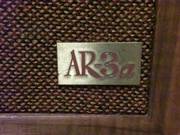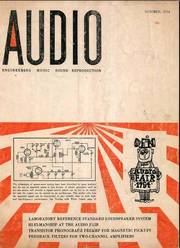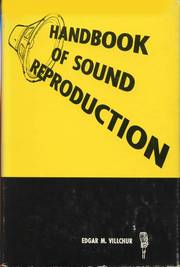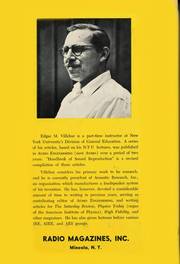Der Autor Edgar M. Villchur war der President von AR
Mit "AR" ist die "Acoustic Research, Inc." gemeint und Edgar M. Villchur war der Chef. Dazu muß man wissen, in USA war schon immer der Chef - selbst der Chef der kleinsten Klitsche - der President oder ein President. - Als ich 1985 zum ersten Male nach USA geflogen bin, wurde mir von USA erfahrenen Freunden dringend angeraten, mir "amerikanische !!" Visitenkarten machen bzw. drucken zu lassen. Da müsse unbedingt "Gert Redlich - President " drauf stehen, sonst bekäme ich nicht mal einen Kaffee angeboten. Ich jedenfalls tat mich schwer damit, ließ die aber dennoch drucken. Und es stimmte. Jede Klitsche hatte einen Presidenten. Der General Manager - also bei uns der Geschäftsführer - zählte dort drüben überhaupt nichts.
.
Auch Edgar M. Villchur war also President (einer "one man show") und werkelte mitsamt Partner einige Jahre vor sich hin, bis er die bis dahin unbekannte Lösung mit der völlig geschlossenen Box heraus fand. Es war die erste Box mit dem von hinten mit Glaswolle voll gestopften und völlig geschlossenem Bass-Lautsprecher.
.
Revolutionary Loudspeaker and Enclosure
Reprinted from US-Hifi-Magazine AUDIO - October 1954
The author describes a fundamentally new loudspeaker system whose 12" woofer utilizes an enclosure volume of only 1.7 cubic feet, but whose bass performance is claimed to be superior to that of a true infinite baffle installation. - by Edgar M. Villchur - President, Acoustic Research, Inc., 23 Mt. Auburn St., Cambridge 38, Mass.
.
THREE OUTSTANDING PROBLEMS
that still plague (plagen) the field of loudspeaker design may he categorized as:
1. How to keep harmonic distortion low in the frequency region below 70 or 80 cps (=Hz), especially at high power.
2. How to keep frequency response uniform and extended at all power levels.
3. How to solve the above two problems without requiring architectural installations, very large cabinets, and difficult final adjustments.
.
Über diese Lautsprecher Entwicklung :
The loudspeaker system here described is the fruit of an investigation that was primarily directed towards solving the first of these problems, that is, towards creating an electro-acoustic transducer (Wandler) that made no compromise with low distortion bass down to 40cps (=Hz). The solution to the distortion problem turned out at the same time to be a solution to the problems of uniform bass frequency response and of cabinet size.
Die Quelle der Verzerrungen:
The greatest source of distortion in a typical high-quality reproducing system is the loudspeaker. Speaker harmonic distortion in the bass range is tolerated in amounts far greater than would ever be allowed in the amplifier or pickup - values between 5% and 10% below 60 cps (=Hz) and at moderate power are common even in high-quality units.
Es ist die Schwingspule
The greatest single source of distortion in the loudspeaker itself is the non-linearity of the voice-coil and rim suspensions (Sicken und Aufhängungen) which hold the cone and voice-coil to the speaker frame. The elastic stiffness of the suspending members, a property which they must possess in order to perform their functions properly, does not remain constant over the excursive path of the cone; the further the cone moves from its central position the greater is the resisting force constant of the suspensions.
Die Entwicklung stockte bislang
The design of these suspensions and of the speaker's moving system has been refined (verbessert) but not changed radically over the last twenty years or so. The situation is comparable to that of the acoustic phonograph in the nineteen twenties - there wasn't much further to go in the direction of improved performance until designers retraced their steps, back to the basic problems associated with converting needle vibrations to sound, and applied a new approach, the electrical one.
.
In the present case, instead of attempting to re-design an already refined mechanical suspension system for a linear force displacement relationship, the elastic stiffness of the mechanical suspension system was substantially eliminated, and a linear, acoustic elasticity (akustische Federkraft) used instead.
.
Thus, the domination of voice-coil motion by the non-linear elastic mechanical suspensions was also substantially eliminated. The phrase "substantially eliminated" can mean many things; here it is used to denote reduction by a factor between 6 and 10.
Acoustic Elasticity - die akustische Rückstellkraft
The acoustic elasticity is provided by the enclosure's sealed-in air, which must be compressed when the cone moves back, and rarefied or stretched when the cone moves forward. In other words the air of the enclosure is used as an elastic cushion (Polster), which supplies to the special speaker the restoring force (die Rückstellkraft) that the moving system is by design deficient (unzulänglich) in, and that it needs.
Such use of the enclosure's air turns out to have most fortunate consequences, and it is possible to reap (ernten) large extra dividends over and above the reduction of distortion. The amount of acoustic elastic stiffness available is determined by the cubic volume of the enclosure; the cubic volume which must be provided (not as a minimum but as an optimum value) is of the order of one-fifth (1/50) the volume of a conventional totally enclosed cabinet for an equivalent speaker mechanism.
Die Funktion der unendlichen Schallwand
The function of an infinite baffle or totally enclosed cabinet is to provide acoustical separation between the waves radiated by the front and back surfaces ot the speaker cone (wir sprechen vom akustischen Kurzschluß), waves which are out-of-phase and would cancel at lower frequencies. One may ask then, why it has not been possible to simply house a speaker in any small enclosed box, or even to close up the back of the speaker frame so that it is airtight (luftdicht), in order to achieve the necessary separation. The answer lies in this same acoustic elasticity referred to, which increases the elastic stiffness of the speaker's moving system and raises its main resonant frequency. The nature of modern loudspeakers is such that below the resonant frequency response falls off rapidly - at the rate of 12db per octave, in terms of pressure, in an undamped unit.
Ein Beispiel:
Suppose, for example, we have a 12" loudspeaker mechanism whose main resonance occurs at 50cps (=Hz) in free air. If we now mount the speaker in a wall the resonant frequency will drop due to the air load mass, perhaps to 45cps (=Hz), and if the speaker has been well designed we can expect good response to something below 40cps (=Hz), with about 6db of attenuation at 32cps (=Hz).
If we now take this same loudspeaker mechanism and mount it instead in a conventional totally enclosed cabinet (a second choice dictated by the landlord) we will find that the resonant frequency is raised by the additional acoustic stiffness of the enclosed air. Probably the best that we can hope for is to keep the resonant frequency at about 50cps (=Hz), an achievement that will certainly require a cabinet volume of over 10 cubic feet. A cabinet of 5 cu. ft. will raise the resonant frequency into the 60cps (=Hz) region, and the system will suffer a corresponding loss of bass response.
Trennung der Membrane - Vorder- und Rückseite
The problem, then, resolves itself into these terms: how provide complete acoustic separation between the front and back of the speaker cone, without raising the resonant frequency above what we want it to be, and without a wall installation or a monster cabinet?
Ein Bass-Chassis mit 10 Hz Resonanzfrequenz
The answer dovetails (stimmt überein) with the solution for suspension distortion referred to previously. We select the values of mass and elasticity for our speaker system as for a conventional speaker, on the basis of the resonant frequency we decide upon. We then design the speaker mechanism with perhaps only 10% of the elastic stiffness that it needs, so that the resonant frequency for the unmounted speaker mechanism is subsonic, of the order of 10cps (=Hz). For reasons that will be apparent a little later, this speaker mechanism is useless as a bass speaker in any conventional mounting - which was not designed for 10cps (=Hz) resonance but for 45cps (=Hz) resonance.
Am Ende eine luftdicht geschlossene Box
The final step in the construction of the complete speaker system follows logically. We enclose the back of the speaker with an acoustically sealed volume of air which will supply the remaining 90% of the elastic stiffness to the moving system, and which will raise the resonant frequency to 45 cps (=Hz). The interior volume of the experimental acoustic suspension speaker, using a 12" woofer and designed according to this principle, is 1,7 cubic feet. Increasing (vergrössern) the cubic volume will - in this case - not improve the performance of the system, but will degrade it.
We can now compare the characteristics of the infinite baffle with corresponding characteristics of the acoustic suspension system. This is done in Table 1.
Speaker Restoring Force
The speaker suspensions (die beiden Aufhängungen) serve two purposes, that of centering the voice coil in the magnetic gap so that it does not rub, and that of providing elastic restoring force to the moving system. The restoring force of a particular speaker cannot be decreased below an optimum value for that speaker. Too low an elastic stiffness will result in increased bass distortion, as the voice-coil will travel out of the path of linear magnetic flux on high-amplitude low-frequency signals, or will actually "bottom" against parts of the magnet structure.
Die Abstimmung der Resonanzfrequenz
The same principle may be explained in terms of the main resonant frequency of the speaker, which, as we have seen, is determined by the values of elasticity (Rückstellkraft) and mass (Masse), both mechanical and acoustical, of the suspended system. Other things being equal it is desirable to have speaker resonance as low in frequency as possible, but too low a resonant frequency results in cone excursions too great for the length of the magnetic path provided by the particular speaker.
Voice-coil excursion in the bass, for constant radiated power, must be quadrupled for each lower octave, and the attenuation of response below resonance protects the speaker against over-large excursions.
Über eine ideale Auslenkung der Schwingspule
Thus when a speaker is designed with the correct resonant frequency, voice-coil excursion is always kept within the limits of linear flux for all signals, regardless of frequency, up to rated power. Small speakers which can only allow short voice-coil travel relative to their power rating, and which provide relatively poor coupling to the air are properly assigned high resonant frequencies, while speakers which allow greater excursion, or can radiate the same power with less excursion due to some special means for matching them to the air, (such as a horn, for example) can be given lower resonant frequencies.
Symentrische Rückstellkräfte in beide Richtungen
With the understanding, then, that the non-linearity of the speaker's elastic restoring force cannot be cured by removing or reducing the restoring force itself, the necessity for substituting an acoustic restoring force for the decimated mechanical one becomes apparent.
Boyle's law tells us that the restoring force will be symmetrical - that it will be the same coming and going. Acoustic pressure is a function of volume, and it makes no difference that the variations in pressure occur above and below normal atmospheric pressure as a reference level.
When the cone moves back the enclosure pressure on the back of the cone is greater than the atmospheric pressure on the front surface; when the cone moves forward the atmospheric pressure on the front of the cone is greater than the pressure of the rarefied enclosed air on the back surface.
Die Luft im Gehäuse - ein unvermeidbares Übel ???
For twenty-five years the air in speaker enclosures has been considered an unavoidable evil. It has been unavoidable because of the necessity for providing acoustical separation between the front and back of the cone, and it has been an evil because of the effect of the added acoustic stiffness raising the resonant frequency of the speaker above its optimum point and cutting off bass response.
Optimal : die Riesenbox oder eine unendliche Schallwand
Thus the enclosed air can be rendered innocuous (harmlos) by providing a very large volume whose acoustic stiffness is negligible (vernachlässigbar); this means, ideally, an infinite baffle wall installation or a very large, well braced cabinet, both of which are impractical in most homes.
Eine andere Lösung - gefaltete Hörner
Folded horns solve the problem, but again at the expense of large size - a horn that delivers clean, non-boomy bass requires a long flared path and an extremely large mouth diameter. Different methods of "tuning out" the stiffness of the enclosed air have also been used, some using Helmholtz resonance, as illustrated by the various and popular bass-reflex type enclosures, and some by air-column resonance. Critical adjustments are usually required for optimum results.
Jetzt : Die Luft als integrales Bestandteil der Box
The enclosed air in the present system is not a necessary evil but an integral and indispensable part of the loudspeaker, without which the speaker could not operate properly. Since we cannot conquer the acoustic stiffness readily we join it and make it work for us. The enclosure volume is so regulated that in conjunction with the mechanical moving system of the speaker the final resonant frequency is precisely what has been intended - about 45cps (=Hz).
Die ersten Versuche
When the first experimental model of the acoustical suspension speaker was planned it was reasoned that the bass performance, at worst, would be equal to that of an equivalent conventional speaker in an infinite baffle. It was known that the experimental speaker would provide complete separation between front and back waves, that the cabinet used no acoustical resonators, and contributed no unwanted stiffness to the moving system, and that the resistive loading on the back of the cone in an infinite baffle would be more equalled by Fiberglas filling in the experimental cabinet. Accordingly a control 12" speaker, identical except for the suspension system, was mounted in a stairwell (Treppenhaus).
Endlich : Ein fundamentaler Bass
The difference bewteen the experimental model and the infinite baffle installation, however, was immediately apparent. The experimental unit, because it did not flatten the bass peaks on large cone excursions, had a fuller and cleaner bass, especially in the 40 to 60cps(=Hz) region. In the beginning it seemed a little unreal to hear the fundamentals of organ pedal notes, which could be felt as, well as heard, issuing from this little box.
Der Sound stimmt - erstaunlich linear
Later measurements of frequency response and harmonic distortion indicated the reasons for the bass sounding as it did. Figure 1 shows the bass frequency response of the experimental model, taken under open field conditions. Bass response uniform within ±1 1/2db, as indicated in Fig. 1, would be ordinary for an amplifier, but is quite unusual for a loudspeaker system. This uniformity of response partly results from the fact that the restoring force is applied smoothly to the whole of the cone surfaces, rather than to the apex and rim (vom Rand bis zum Scheitelpunkt) of the cone (Membrane) by mechanical suspensions, and partly from the optimum damping of the resonant peak.
Kein "Booming" mehr
The practical result of such uniform response is the absence of boominess. Speech program material, which normally contains no energy below 100 cps (=Hz) gives no hint of the fact that the woofer reaches down into the low bass. Organ pedal notes, bowed or plucked double basses, etc., are reproduced true in pitch and without ringing.
Jetzt gilt das Ergebnis nur für die gesamte Box
It must be emphasized that the reproduced response curve is for a complete system rather than for a loudspeaker mechanism alone, mounted as the testing laboratory sees fit. As an illustration of the necessity for care in interpreting response curves for loudspeakers alone, it has been demonstrated that variations in mounting the same speaker in different commercial cabinets can change the effective bass cut-off frequency by an octave, and the amplitude of the bass resonant peak by more than 10db.
Linear herunter bis 40Hz
It must also be emphasized that the resonant frequency of 45cps(=Hz) is for the complete system rather than for an unmounted speaker mechanism, or for a speaker mechanism mounted by the testing laboratory in an infinite baffle. The value of 45cps(=Hz) was chosen to give full response down to slightly lower than 40cps(=Hz); this low-frequency limit was determined to be as low as practically required. Although the above determination was made on the basis of direct experiment with various types of program material, it is supported by authorities in the field, such as Olson. *1
Weniger Klirrfaktor als bisher
The harmonic distortion of the experimental model speaker was reduced, from that of the control model in the infinite baffle, by a factor of about three. The harmonic distortion of a later model was measured by an outside testing laboratory and found to reach 1.4% at 46cps(=Hz), 10 watts input. *2
Ein kleines Gehäuse ist kein Nachteil mehr
It will therefore be seen that this speaker system has not been designed as a compromise "small unit," and it was not intended that a handicap weighting of its performance be allotted to it because of the small size-of its enclosure.
It is the author's opinion that the bass performance of a speaker with given magnetic and electrical design will be optimum, at the present state of the art, when a moving system with the acoustical suspension is utilized; the small enclosure not only entails no penalties but contributes a tremendous advantage from the point of view of performance quality.
It is anticipated that the acoustical suspension principle will become increasingly universal in the industry, and will have general application to speaker systems of all sizes. One obvious application is in electronic organs, where pedal note fundamentals of low frequency can be produced cleanly and at high power from a speaker system installed right in the console.
Damping - die Dämpfung mit Glaswolle
The amount of Fiberglas damping material in the enclosure (see Fig. 2) is fairly critical. The Fiberglas, in the amount used, completely damps out standing waves at higher frequencies (a task made easier by the small cabinet dimensions, since the standing waves that tend to form are shorter wave lengths, and such sound waves are more easily absorbed) and reduces the Q (Impedance) of the moving system so that the main resonant impedance peak is broadened (verbreitert). The Q can be controlled at will; too little Fiberglas yields an output peak in the bass, while too much overdamps the system and attenuates the bass response.
Das Gehäuse ist direkt mit dem Chassis gekoppelt
Since the enclosure is actually an integral part of the speaker it cannot be built like conventional cabinets. An acoustical seal must be provided, and the unrelieved pressures (inneren Bewegungen oder Druckschwankungen) that are built up are so great that an unusually large number of ribs and braces are required, together with 24" walls.
Figure 3 is a photograph of the experimental model of the loudspeaker, its outside dimensions measuring 19" x 19" x 11". It uses a 12" woofer and an outside tweeter, the latter not shown. The production model of the acoustical suspension loudspeaker that will be exhibited at "The Audio Fair" will not be square, for greater convenience in use on shelves or bookcases, and will utilize a 12" woofer with 52oz Alnico 5 magnet, plus a high-frequency section mounted within the enclosure.
Es funktioniert nur beides zusammen
Either the speaker mechanism or the enclosure is useless by itself. The speaker mechanism alone is only half a speaker, and mounting it in any conventional cabinet would be no more feasible than mounting a conventional 12" speaker in the totally enclosed cabinet of approximately 1,7 cubic ft. interior volume.
Figure 4 illustrates by electrical analogy the substitution of acoustical for mechanical stiffness in the moving system. The total compliance, that is,
kommt noch : Formel : C speaker Cair C speaker X Cair
is not changed by the new design from its optimum value in terms of the moving mass and length of linear magnetic path. An examination of the negative side of the ledger will reveal the fact that the acoustic suspension speaker system is relatively inefficient. The efficiency rating does not, however, fall outside the range of values for conventional direct radiators and a 10-watt amplifier is sufficient to provide ample volume for a room of 3,000 cubic feet.
Conclusion
Some of the reasons for the relative inefficiency are:
- 1. There are no acoustical resonators employed in coupling the cone to the air.
- 2. The moving system has purposely been given a low Q, to damp the bass resonant peak, and has a relatively high mass reactance in the commercial model.
- 3. The voice-coil gap cannot be made very narrow due to the nature of the centering spider, although the gap width does not fall outside the range of values for conventional units. The acoustical suspension speaker system can, of course, be used as the driver unit for a horn where high efficiency is required.
A patent application for the speaker system described in this article has been filed by the author.
.
Bildunterschriften geparkt :
Fig. 1. Typical bass frequency response, on axis, of the acoustic suspension speaker under open field conditions.
Fig. 2. Experimental enclosure, showing Fibergfas made up in cheesecloth-covered "pillows." The enclosed volume of air, rather than mechanical suspensions, supplies elastic restoring force to the special 12-inch speaker.
Fig. 3. The assembled experimental speaker and enclosure.
Fig. 4.
(a) Electrical-mechanical analogy of the moving system of a conventional speaker in r» - totally enclosed cabinet. Since C.ir is made as large as possible, the non-linear Cspeak/ determines the elastic stiffness of the system.
(b) Electrical-mechanical analogy of the moving system of the acoustic suspension speaker. Since Cspeaker is made very large, the linear Cair determines the elastic stiffness of the system. The resultant total elastic stiffness, however, is not changed from its optimum value.
1 Harry F. Olson, "Elements of Acoustical Engineering" D. Van Nostrand Co., 2nd ed., 1949, p. 477. Dr. Olson lists 40 cps (=Hz) as the low-frequency limit required for the reproduction of orchestral music with perfect fidelity.
2 These figures were taken with the electrical input as reference level, and are therefore favored by the low efficiency of the system.






